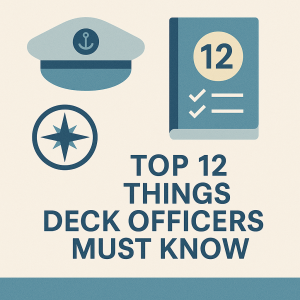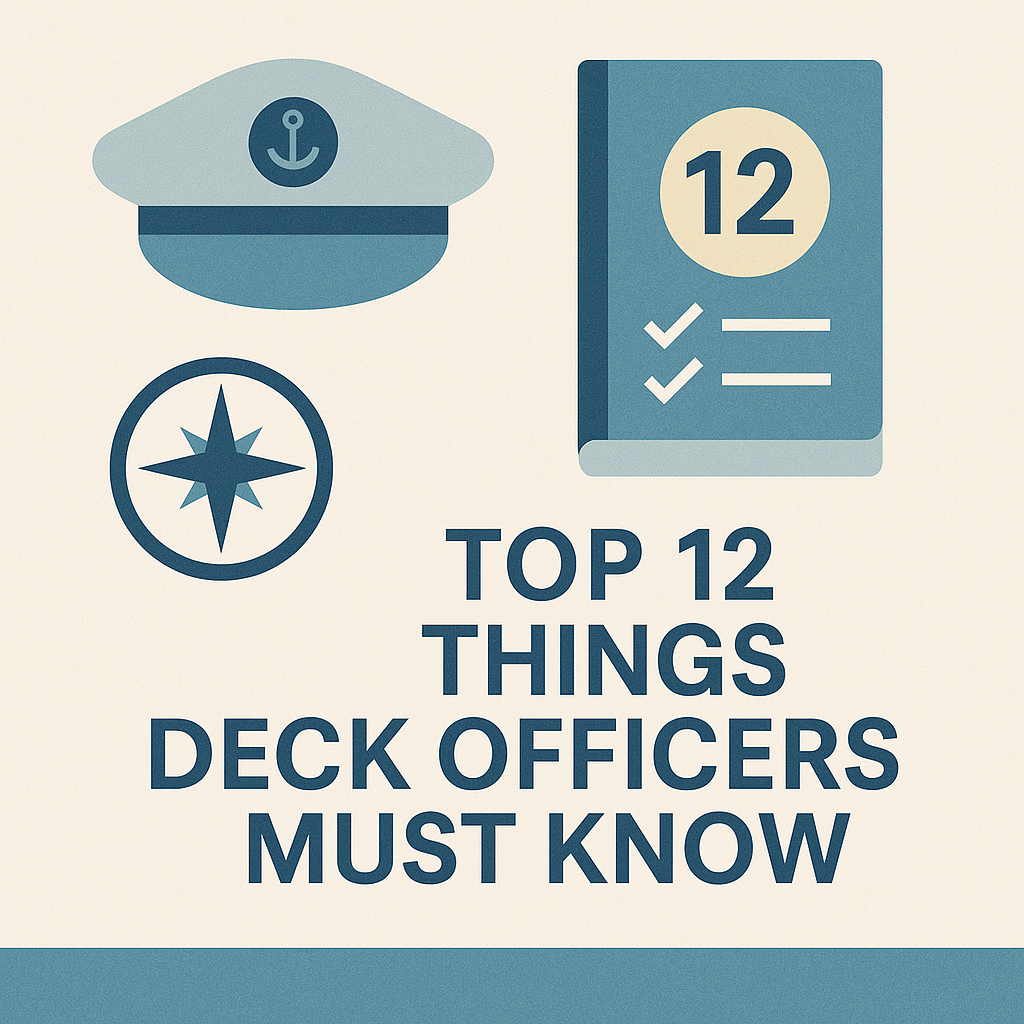Mastering main engine operations from the bridge is crucial for modern deck officers. Learn the top 12 essential skills, safety protocols, and technologies every officer must know to ensure efficient, safe ship navigation.
Modern ships are equipped with advanced engine control systems that allow the main engine to be operated directly from the bridge. For deck officers, especially those transitioning from cadetship to officer watchkeeping duties, understanding how to safely and efficiently operate the main engine from the bridge is not just a technical requirement—it’s a matter of safety, compliance, and professional confidence.

Why Understanding Bridge-Based Main Engine Control Is Critical
Ship propulsion control has evolved dramatically. With the widespread use of Integrated Automation Systems (IAS) and bridge control overrides, deck officers now play an essential role in directly interfacing with main engine commands during maneuvers, emergencies, and port operations.
The STCW Code (Section A-VIII/2) and IMO Model Courses 7.03 & 7.04 stress that a deck officer must be fully aware of propulsion systems, control interfaces, and safe operational limits. Errors in bridge-based engine operation have been cited in over 25% of accident reports involving port collisions or grounding, according to the MAIB Annual Report (2023).
1- Understanding Engine Control Modes
Modern main engines, particularly those on large container ships or tankers, often have multiple control modes:
- Engine Control Room (ECR) Mode
- Bridge Control Mode
- Local Emergency Mode
Deck officers must confirm which mode is active before giving commands. Control transfer from the ECR to the bridge must be verified via alarms or indicators.
Real-World Insight: On a Wärtsilä RT-flex96C propulsion system, failing to verify bridge control mode activation before maneuvering caused a 15-second response delay during berthing—a near-miss recorded by CHIRP Maritime (2022).
2- Familiarity with Telegraph Commands and Response Time
Unlike the traditional engine telegraph with bells and handles, modern interfaces are digital—touchscreens, knobs, or even joysticks. Deck officers must:
- Know the engine’s startup lag time
- Understand limitations (e.g., max RPM in harbor)
- Confirm RPM changes are executed as ordered
For example, the MAN B&W 6G70ME-C9.5 engine has a standard response delay of 6–8 seconds in bridge mode due to safety interlocks.
“A second’s hesitation can cause a delayed turn in tight harbor conditions,” said a pilot aboard a VLCC in Fujairah.
3- Emergency Stop and Override Procedures
Bridge control must include awareness of:
- Emergency Stop Buttons
- Override Sequences
- Backup Modes in Case of Automation Failure
According to IMO Circular MSC.1/Circ.1182, bridge officers must train regularly on manual overrides and familiarize themselves with propulsion emergency procedures. This is often simulated during drills in accordance with ISM Code Chapter 8.
4- Load-up and Load-down Routines
Engineers usually handle this, but deck officers must understand what happens when they request “Dead Slow Ahead” or “Half Astern.”
Engines like Sulzer’s 2-stroke low-speed engines take time to transition between speeds. Improper RPM change requests—too fast or too frequent—can trip alarms or cause surging.
Training Note: Some companies now include load routine animations in bridge simulators provided by Kongsberg or Transas.
5- Propeller Pitch Awareness (For CPP Systems)
Ships with Controllable Pitch Propellers (CPP) behave differently from fixed-pitch setups. Instead of varying RPM, the pitch angle adjusts to change thrust. Officers must know:
- Neutral pitch settings
- Maximum pitch allowed in port
- Directional changes through pitch or RPM?
“I saw a cadet give ahead RPM with astern pitch—the ship shuddered but didn’t move!” recalls C/O Andres on a Ro-Pax ferry.
6- Communication with Engine Room
Even in full bridge control, coordination with the engine room is vital. During standby or unmooring, engine staff may manually override controls or activate preheating systems.
Use of standard IMO phrases and company-specific Standing Orders is crucial for clarity. Many groundings investigated by Paris MoU cite communication failures between bridge and engine room.
7- Alarm Acknowledgement and Response Protocols
Bridge control systems trigger alarms for:
- Slow response
- Fuel pressure deviations
- Overheating
Deck officers must not ignore them. Alarms must be acknowledged, investigated, and logged. Integrated displays (like K-Chief 700 by Kongsberg) show cascading effects—officers should be trained to interpret them.
8- Rudder and Engine Coordination During Maneuvers
Bridge teams must coordinate rudder use with engine output to avoid overcorrection. Rudder delay time, helm order execution, and main engine throttle must align—especially during berthing or canal navigation.
Example: In the Ever Given Suez Canal incident (2021), analysts noted that excessive rudder combined with delayed engine responses may have contributed to instability.
9- Environmental Limits: Engine Load, Temperature, and RPM Restrictions
During cold start operations, or in ECA zones, engine load limits may be enforced by the EMS (Engine Management System). The deck officer should:
- Know RPM restrictions based on engine load
- Understand shaft generator modes
- Avoid rapid astern-ahead transitions
IMO’s NOx Technical Code (2017) and MARPOL Annex VI impose strict emission controls that can affect engine behavior.
10- Fuel Changeover Impacts
Many ships operate on dual-fuel or low-sulphur fuel while entering ECAs. During this changeover (e.g., from HFO to MGO), engine response time and stability vary.
Deck officers must be briefed about:
- Changeover timing
- Fuel compatibility impacts
- Control limitations
ClassNK (2022) recommends including fuel mode indication on bridge control displays for transparency.
11- Understanding Engine Automation and Fail-Safes
With intelligent monitoring systems (like ABB’s Marine Advisory System), engines monitor their own performance and reject dangerous commands. Deck officers should:
- Know what inputs may be ignored or delayed
- Understand how system prioritizes safety vs command
This knowledge helps avoid unnecessary radio calls to the Chief Engineer.
“Bridge gave full ahead but engine only allowed slow due to lube oil pressure—it saved us from a breakdown,” says 3/O Kristine, Norway.
12- Use of Bridge Simulation and ECDIS Integration
Many vessels integrate engine RPM readouts into the ECDIS. This gives a full picture of navigation and propulsion. Understanding how to interpret these alongside radar overlays helps avoid over-reliance on human memory or verbal orders.
ECDIS-linked systems from Wärtsilä NACOS now include engine readiness signals. A blinking prompt can mean the engine isn’t warmed up or pitch control is disabled.
–
Case Study: Engine Failure in Restricted Waters
In 2022, a bulk carrier experienced an engine shutdown while navigating a strait. The officer on watch had not verified bridge control authority nor acknowledged an earlier alarm for low scavenging pressure.
The incident led to grounding and $4M in hull damage. MAIB concluded that better familiarization with alarm protocols and bridge control logic could have prevented the accident.
This underscores the importance of hands-on simulator training and emergency drills.
Frequently Asked Questions (FAQ)
Can deck officers start the engine from the bridge?
Yes, if the control mode is transferred to the bridge and safety checks (lubrication, fuel pressure, air) are met.
Is the bridge always in control of the engine?
No. Control may be retained in the Engine Control Room or even locally. Always confirm the active control station.
How do you know the main engine is responding correctly?
Watch for RPM feedback, alarm silence, and visual confirmation on the propulsion screen.
What if there’s a delay in engine response?
Check if bridge control was properly transferred. Confirm with the engine room. Delays may also occur due to interlocks.
Do deck officers need to know engine technical details?
Basic understanding is essential, especially related to engine control systems, delays, and operational limits.
Are there training modules for this?
Yes. IMO Model Courses, Lloyd’s Maritime Academy, and simulators from Kongsberg and Transas include engine control training for deck officers.
Conclusion: Bridge Control Is a Command Responsibility
Operating the main engine from the bridge is no longer an occasional task. It is an everyday operational responsibility. With increasing automation, real-time performance monitoring, and environmental regulations, the deck officer’s understanding of propulsion control systems is crucial.
From verifying control modes to interpreting alarms, every action from the bridge can affect ship safety, efficiency, and reputation. Continuous learning, simulation drills, and cross-discipline communication are the keys to mastering this critical skill.
In today’s maritime world, true seamanship includes knowing what’s under the hood—even from the wheelhouse.
References
- IMO. STCW Code and Model Courses. imo.org
- CHIRP Maritime. (2022). Human Element Reports. chirp.co.uk
- MAIB. (2023). Annual Accident Investigation Reports. gov.uk/maib-reports
- Wärtsilä. Marine Automation and Engine Systems. wartsila.com
- MAN Energy Solutions. Two-Stroke Engine Operating Manuals. man-es.com
- Kongsberg Maritime. Integrated Automation Systems and ECDIS. kongsberg.com
- ClassNK. (2022). Fuel Handling and ECA Compliance Guide. classnk.or.jp
- Paris MoU. Port State Control Reports. parismou.org
- Lloyd’s Maritime Academy. Training for Deck Officers. lloydsmaritimeacademy.com
- Transas. Bridge Simulation Training Systems. transas.com

